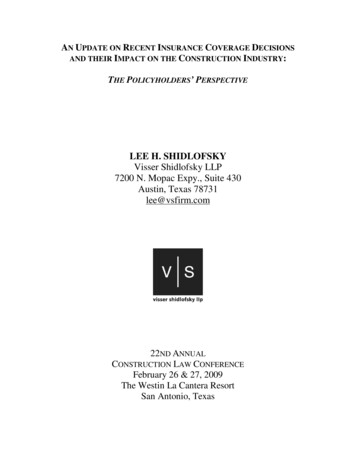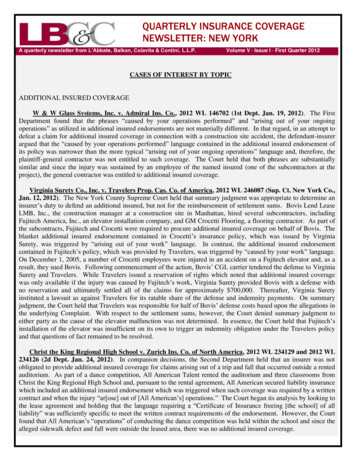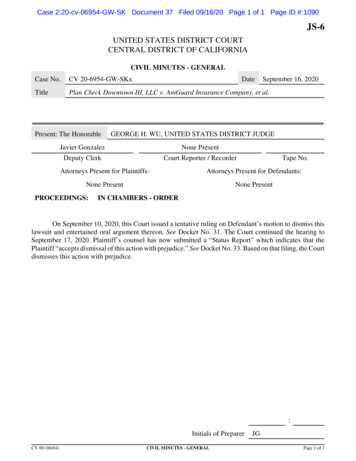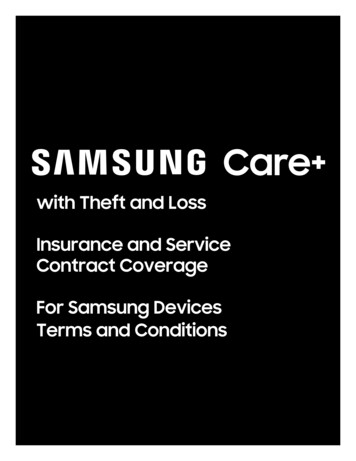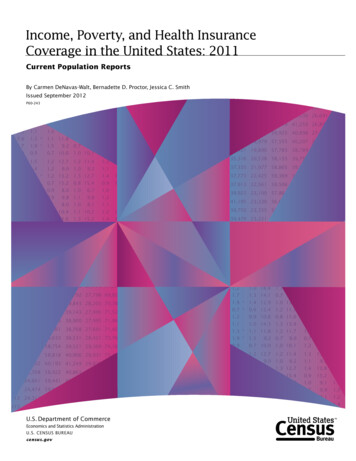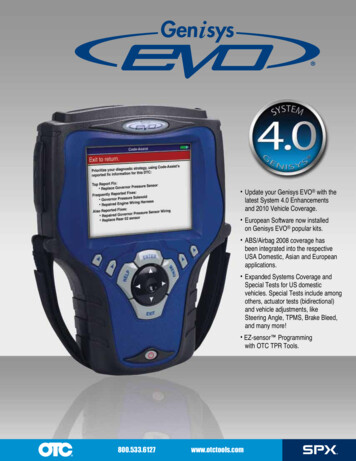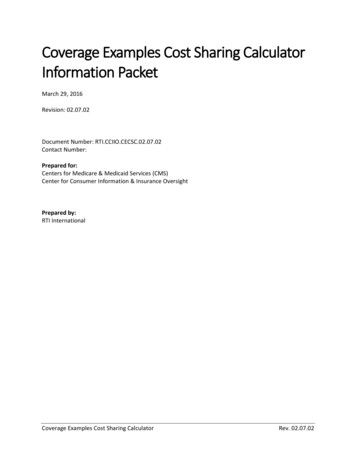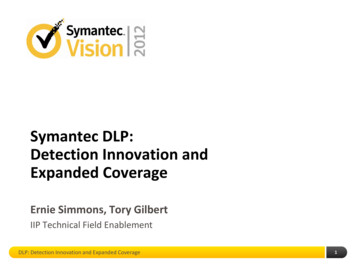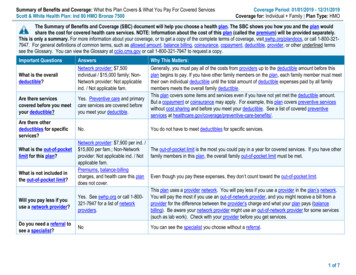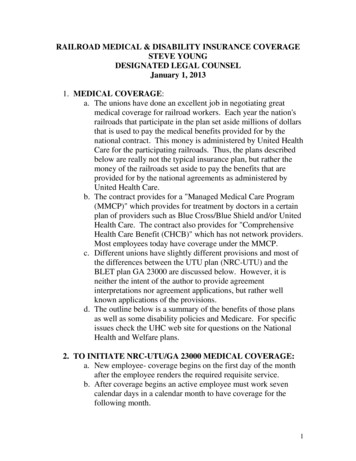
Transcription
RAILROAD MEDICAL & DISABILITY INSURANCE COVERAGESTEVE YOUNGDESIGNATED LEGAL COUNSELJanuary 1, 20131. MEDICAL COVERAGE:a. The unions have done an excellent job in negotiating greatmedical coverage for railroad workers. Each year the nation'srailroads that participate in the plan set aside millions of dollarsthat is used to pay the medical benefits provided for by thenational contract. This money is administered by United HealthCare for the participating railroads. Thus, the plans describedbelow are really not the typical insurance plan, but rather themoney of the railroads set aside to pay the benefits that areprovided for by the national agreements as administered byUnited Health Care.b. The contract provides for a "Managed Medical Care Program(MMCP)" which provides for treatment by doctors in a certainplan of providers such as Blue Cross/Blue Shield and/or UnitedHealth Care. The contract also provides for "ComprehensiveHealth Care Benefit (CHCB)" which has not network providers.Most employees today have coverage under the MMCP.c. Different unions have slightly different provisions and most ofthe differences between the UTU plan (NRC-UTU) and theBLET plan GA 23000 are discussed below. However, it isneither the intent of the author to provide agreementinterpretations nor agreement applications, but rather wellknown applications of the provisions.d. The outline below is a summary of the benefits of those plansas well as some disability policies and Medicare. For specificissues check the UHC web site for questions on the NationalHealth and Welfare plans.2. TO INITIATE NRC-UTU/GA 23000 MEDICAL COVERAGE:a. New employee- coverage begins on the first day of the monthafter the employee renders the required requisite service.b. After coverage begins an active employee must work sevencalendar days in a calendar month to have coverage for thefollowing month.1
Employee works at least seven days in March. He hascoverage for April.c. An extra board employee must either work seven calendar daysin a calendar month or be available for service for sevencalendar days in a calendar month to have coverage. Example – employee works 7 days in June 2008 andwould then have coverage for July 2008. A “calendar day” means the employee must workduring a calendar day. A 300 mile run that goes to work on Monday June 1,2008 would qualify as one calendar day, not 3 days. Vacation pay received in a month counts as calendardays. Extra board guarantee pay counts as a calendar day.d. Opportunity Rule: If an employee returns to work fromfurlough, suspension, dismissal or disability (includingpregnancy) or commences work as a new hire at a time during amonth when there is not an opportunity to render compensatedservice at least seven calendar days during that month, theemployee will be deemed to have satisfied the seven day rule,provided he/she is available to work, or actually works, everyavailable work opportunity during that month.3. FURLOUGH COVERAGE ISSUES:a. A furloughed employee has coverage for the month of furloughplus four additional months. This includes all dependents.b. Example: Furloughed February 18, 2010 – coverage extendsthrough June 30, 2010 for the employee and all dependents.The employee pays no premium during this period of extendedcoverage.c. If a furloughed employee is recalled to work at least one day inthe four month period of furlough and then again furloughed,coverage is extended another four months. Example – Employee is furloughed February 18, 2010and thus has coverage through June 30, 2010. If he isrecalled and works for one day in June and then againfurloughed, he would have extended coverage foranother four months through October 31, 2010.2
d. If a furloughed employee is recalled for one day and works oneday after the extended coverage expires, he establishes anotherfour month period of extended coverage. Example: Employee is furloughed February 18, 2010and is recalled July 5, 2010 and works one day. Thereis no coverage for July, but the employee would againhave coverage beginning August 1, 2010 which wouldend November 30, 2010.e. Vacation pay received by a furloughed employee after the fourmonths of coverage expires does not create or extend coverage. Example: Employee is furloughed February 2010 butnot recalled. Employee receives vacation pay in July2010 after the four months of extended coverageexpires. The vacation pay does not extend coverageand coverage ends June 30, 2010.f. Vacation pay received while furloughed and still undercoverage, does not extend medical coverage: Example: Employee is furloughed February 18, 2010and has coverage through June 30, 2010. If theemployee receives vacation in June 2010, the coverageis not extended.4. RESIGNATION:a. All coverage ends the day one resigns.b. Example – employee resigns on August 1, 2008. Coverageends on August 1, 2008 for the employee and all dependents.5. DEATH OF EMPLOYEE:a. When an employee covered under the active plan, GA 23000dies; the dependant spouse is entitled to 4 months of coverageafter the month of death. Thus, if the employee dies in June,coverage for the spouse would end October 31.b. Thereafter the spouse could purchase the plan at the COBRAGA 23000 cost for up to 36 months.c. Note - the spouse may also purchase GA 23111 (A), (B), or (C)after the expiration of GA 23000.6. MARRIAGE:a. New spouse is eligible for coverage the first day of marriage3
Marriage license has to be sent to UHC as proof ofmarriage.b. Ex-spouse loses coverage the day the divorce is final.7. CHILDREN:a. Unmarried children are covered until age 19.b. EFFECTIVE JANUARY 1, 2011 children have extendedcoverage until their 26th birthday. Under the Health Care Reform Act dependent childrenof active employees covered under the NRC/UTU – GA23000 will now have coverage up to the first day oftheir 26th birthday. However, to be eligible the childmust not have access to other coverage, such as fromtheir own job or that of their spouse. This does not apply to retired employees covered underGA 46000. This provision does not apply to the dental and visionplans.c. Unmarried children are covered up to age 25 if full timeenrolled in college. Full time means 12 or more hours asemester.d. Unmarried children over the age of 19 who have a permanentphysical or mental disability that began before age 19 willcontinue to have ongoing coverage.e. Step children and adopted children are covered.f. Grandchildren are covered if they live with and depend uponthe covered employee for support.8. COVERAGE WHEN THE EMPLOYEE IS SUSPENDED ORDISCHARGED:a. Coverage for 4 months following the last month ofcompensated service for the employee and all dependents.b. Example: Employee is suspended on March 22, 2008.Employee and all dependents have full coverage for March,April, May, June and July 2008.c. Remember one can buy the insurance at the Carrier’s cost(COBRA) for up to 18 months after the insurance ends. Thecost is 664.99 per month for the employee and 442.58 for thespouse for all children.4
9. LEAVE OFABSENCE:a. Coverage for 1 month following the last month of compensatedcoverage.b. Example: Employee takes a leave of absence on March 22,2012. Employee and dependents have coverage for March andApril 2012.c. COBRA coverage is available thereafter.10. FAMILY MEDICAL LEAVE COVERAGE:a. If an employee takes FMLA because of their spouse, childrenor parent has a serious health condition the employing railroadis required to provide coverage for up to 12 weeks. Thereafter,COBRA is available.b. If an employee takes FMLA because the employee has a serioushealth condition, the employee has coverage for the year theleave begins and two years thereafter. Dependents havecoverage for 1 year less than the employee. This is pursuant tothe union contract and is not an issue that is actually covered byFMLA law. Example: Employee begins FMLA (because of his orher own serious health condition) March 1, 2008.Employee has coverage for 2008, 2009 and 2010.Dependents have coverage for 2008 and 2009. If the employee worked long enough during the yearFMLA begins (for his or her own serious healthcondition) to earn a vacation for the following year,coverage is extended for the employee and thedependents for an additional year. Remember FMLAleave is only good for four (4) months in a year. Example: Employee begins FMLA (because of his orher own serious health condition) September 1, 2008.Employee has coverage for 2008, 2009, 2010 and 2011,assuming vacation pay earned in 2008 is received in2009. Dependents would have coverage for 2008, 2009and 2010.5
11. PLANS GA 23111- Plans A, B, Ca. Three plans are now offered for those that might not otherwisehave coverage. These plans are intended to provide coveragewhen an active employee loses coverage.b. These are medical insurance plans, but they do not have theprescription drug coverage. However the plans doautomatically have a partnership with United Health Allies,including the major drug stores (Walgreens, CVS, Wal-Mart)which provides prescription drugs at discounted prices from25% to 50% off retail prices.c. Plan A: Cost 335 per month for the employee and anadditional 335 per month for all dependents. So anemployee, wife and 2 children could purchase thepolicy for 670 per month. There is 1000 per person deductible. Thereafter the plan pays 50% of covered costs.d. Plan B: Cost 485 per month for the employee and anadditional 485 per month for all dependents. So anemployee, wife and 2 children could purchase thepolicy for 970 per month. There is 750 per person deductible. Thereafter the plan pays 60% of covered costs.e. Plan C: Cost 625 per month for the employee and anadditional 625 per month for all dependents. So anemployee, wife and 2 children could purchase thepolicy for 1,250 per month. There is 500 per person deductible. Thereafter the plan pays 70% of covered costs.f. All three plans have a lifetime maximum amount of coverage of 500,000 per person.g. There is NO PRE-EXISTING EXCLUSION for any of Plan A,B or C.h. These plans are available to any railroad worker who otherwisedoes not have coverage and can be purchased until Medicarebegins.i. All three plans pay 75% of inpatient drug abuse care.6
j. Once a plan is selected the insured cannot change the plan for 2years, or until the next open enrollment.k. All three plans are available to any active railroad worker thatloses coverage, but the worker must apply within 4 months oflosing the active coverage.12. WELLNESS PLAN:a. Effective July 1, 2008 a FREE wellness program is availableunder GA 23000 to help active employees quit smoking and/orlose weight.b. A nurse is available to assist with a plan to lose weight or quitsmoking.c. The plan will pay for “nicotine” patches .d. Nurseline phone number is (866) 735-5685.13. EMPLOYEE MONETARY CONTRIBUTION TO THE PLAN:a. As of July 1, 2012 the monthly employee contribution is 198per month. This is withheld from one's check and contributedto the plan.b. The employee contribution is the monthly amount paid by theemployee as the "employee's contribution."c. The employee contribution was reduced to 200 on January 1,2012 and it will not exceed this amount until July 1, 2016,when it may increase to a maximum of 230.d. For those covered under the BLET agreement the contributionis currently 198.00. On July 1, 2016 it will be the lesser of15% of the Carrier's monthly payment rate for 2016 or 230.14. ANNUAL DEDUCTIBLE:a. There is a annual deductible for those who get treatment underMMCP (network provider care) as follows which is currentlycapped as follows: 200 annual deductible for a member and 400 for afamily for non co-pay events. Non co-pay events aretypically MRI's, X-rays, surgery. The maximum annual deductible to paid is 1,000 forthe individual employee and 2,000 for the family. For those covered under the BLET agreement, themember deductible is 150 effective January 1, 2013and is raised to 200 effective January 1, 2014. The7
family deductible is 300 January 1, 2013 and is raisedto 400 January 1, 2014.15. CO-INSURANCE PAYMENTS:a. The plan pays 95% of all in network non co-pay services andthe employee pays 5% with a maximum annual out of pocket of 1,000 for employee and 2,000 for the family.b. For those covered by the BLET agreement, the co-insurance is 750 for the member and 1,500 for the family in 2013 and israised to 1,000 for the member and 2,000 for the familyJanuary 1, 2014.c. Example: Member goes to the doctor with arm pain. Doctorprescribes medication and rest. Member pays 20 co-pay and no more. No deductible or co-insurance payment as this is a copay visit.d. Example: Member goes to the doctor with arm pain. Doctorprescribes medication and an MRI that costs 1,000. Member pays co-pay for an office visit. Member pays deductible of 200. Member’s deductible for the year is met. Member pays 5% of the remaining 800 which is 40.e. Example: Member meets annual deductible of 200 and coinsurance of 1000. Member’s family incurs non co-pay bills of 22,000.Member then pays a 200 deductible and an additional 1,000 co-insurance. Gets credit towards family deductible and co-insurance. Member only has co-pays for remainder of the year.16. CO-PAYS:a. Co-pays for physical therapy, chiropractic, physician’s assistantcare and nurse practitioner care - 20 per visit.b. Co-pays for specialist such as an orthopedist are 35 per visit.c. Emergency room co-pay is 75 per visit unless admitted to ahospital due to the emergency room visit in which case there isno co-pay.d. 20 co-pay for urgent care visit.e. 10 co-pay for a convenient care clinic visit.8
f. Check the UHC site for a listing of urgent care centers andurgent care centers located in your area.g. Example: Member goes to ER with skin rash and is treated andreleased for poison ivy. Total charges are 625. Member pays 75 co-pay. Member pays 200 deductible. Member pays 5% of remaining balance of 375 of 17.50. Convenient Care clinic would only require 10 co-payand nothing more.17. FLEXIBLE SPENDING ACCOUNT:a. For those covered under the BLET 2012 national agreement,there is a voluntary flexible spending account provision thatbecame effective January 1, 2013.b. Under this provision an employee may elect to contribute up to 2,500 per in pre-tax dollars to a fund which will be used to payfor co-pays, deductibles and co-insurance.c. If the all of the money put into the FSA during year is not used,the employee is entitled to be reimbursed the unused funds.d. The advantage to the plan is simply that the funds used to payco-pays, deductibles and co-insurance are pre-tax dollarsinstead of after tax dollars.e. This plan may be terminated for any craft if enrollment does notmeet 5% of the eligible employee population in the craft for2015 Plan year, or 7.5% of the eligible employee population inthe craft for the 2015 Plan year and succeeding Plan Years.18. REFERRALS:a. It is not necessary to get a referral from a primary carephysician to a specialist, so long as the specialist is within thecontract plan. Example: Employee has a back injury and wants to seean orthopedic surgeon. The employee may see thesurgeon without a referral and the plan will pay the fullcontract price for all procedures, less the co-pays.9
b. A doctor or provider that is a part of the contract plan is notallowed to charge the covered employee or dependants morethan the contract price for the service performed. Example: Doctor performs a procedure for which thecontract price is 250. The doctor must accept thecontract price of 250 for the procedure. Should thedoctor send a bill for more than 250 the patient is notrequired to pay any additional charges.19. HEARING BENEFIT:a. There is an annual 600 benefit for hearing.b. Includes testing and hearing aids.20. DENTAL BENEFIT:a. Active employees have a annual dental benefit of 1,500 for theemployee and 1,500 for each dependent.b. There is also a maximum 1,000 annual orthodontic benefit.c. The employee must have one year of service and qualified inthe month prior to use by working at least seven days.d. It ends one month after the month of retirement,e. If discharged, suspended or furloughed -coverage for thatmonth plus four.f. The plan can be purchased for COBRA coverage for 32.18 permonth for up to 18 months.21.VISION:a. One eye exam every 2 months, counting from the most recentservice date. This is covered in full for an in network provider.The plan will pay up to 35.00 for an out of network provider.b. Lenses and frames for corrective lenses every 24 months.Single vision lenses, bifocal lenses, trifocal lenses andlenticular lenses are covered in full for a network provider. Foran out of network provider the plan pays up to: 25.00 forsingle vision lenses; up to 40.00 for bifocal lenses; up to 55.00 for trifocal lenses; and up to 80.00 for lenticular lenses.c. Frames: Plan pays up to 115.00 for frames and 80% of theframe costs for over 115.00.d. Contact lenses: One pair of visually necessary contact lenses (or twovisually necessary separate contact lenses), or one years10
worth of 1-day, 7-day or 14-day disposable contactlenses, every 25 months, counting from the most recentservice date. This benefit is provided in lieu of an notin addition to the eyeglasses lens and frame benefit.During any 24 month period, one may receive either theeyeglass lens and frame benefit OR the contact lensbenefit, but not both. The plan pays a 105.00 allowance toward theevaluation and a 15% discount from the cost of thecontact lens exam for an in network provider. The planpays up to 105.00 for an out of contract provider aswell. If one has cataract surgery or an extreme acuity visionproblem that cannot be corrected with spectacle lenses;certain conditions of Anisometropia or Keratoconus thecontact lenses are covered in full if prescribed by an innetwork provider and prior approval is obtained fromthe plan. The plan pays up to 210.00 for an out ofnetwork provider if all of the stated conditions are met.22. EARLY RETIREMENT HEALTH & WELFARE PLAN – GA46000:a. This is a comprehensive plan for employees who retire at age60 with 30 years of service.b. The plan pays 80% of covered charges The plan covers office visits and diagnostic testing.c. There is 100 deductible.d. The prescription drug plan is the same as GA 23000. GA 46000 uses the same Medico plan as GA 23000. 2 Co-pay for generic drugs. 6 Co-pay for brand name drugs. 5 Co-pay for up to 90 day supply at mail order homedelivery.e. The plan also covers the qualifying employees’ spouse anddependents until the employee reaches age 65. Example: Employee retires at age 60 with 30 years ofservice on March 1, 2008. Employee’s spouse is 59 onMarch 1, 2008. The spouse would begin coverage11
f.g.h.i.under GA 46000 on March 1, 2008 and would continueto be covered under GA 46000 until the employee was65. The spouse could buy the plan after the employeereaches age 65 for 796.46 per month for up to 36months. The cost for a child is 218.85.If an employee is on a disability and is covered under GA23000 on his or her 60th birthday, the employee qualifies forGA 46000 and so does the spouse and dependents. Example: Employee is granted an occupationaldisability at age 57 and is covered under GA 23000 atage 60. The employee’s spouse would begin coveragewhen the employee turns age 60 and would remaincovered under GA 46000 until the employee turns 65.1. Note: This the same plan for those that take anormal retirement at age 60 with 30 years ofservice.Once the employee qualified for Medicare at age 65 the GA46000 no longer covers the employee and he/she only hasMedicare. Example: Employee last worked when he was 57, butremains on GA 23000 until 60 (coverage for year ofinjury plus 3 with vacation pay). When GA 23000expires on December 31 (the year the employee turns60) then Medicare starts
as well as some disability policies and Medicare. For specific issues check the UHC web site for questions on the National Health and Welfare plans. 2. TO INITIATE NRC-UTU/GA 23000 MEDICAL COVERAGE: a. New employee- coverage begins on the first day of the month after the employee renders the required requisite service. b.
